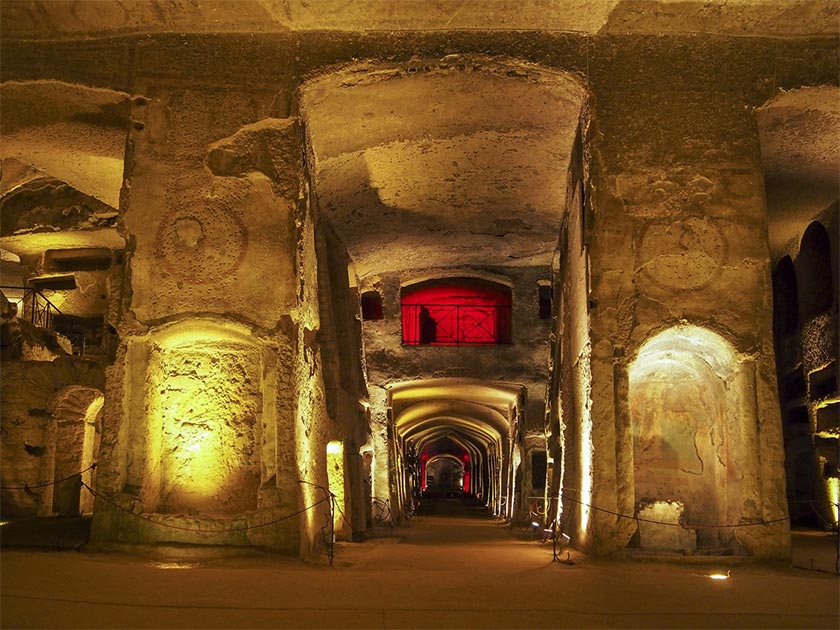Why the Bones of San Gennaro Were Removed from the Catacombs
The city of Naples in Italy has much to offer and is said to be the birthplace of pizza as well as being known for its beauty, culture, and art. One of the most unique historical sites in Naples are the catacombs of San Gennaro, an ancient Christian burial ground and place of worship. This subterranean area provides a unique insight into history and the development of Christianity in the area.
History of San Gennaro Catacombs
Since ancient times, the residents of Naples and the surrounding vicinity, carved underground passageways and chambers into the soft volcanic rock. In the Classical era, members of the elite created catacombs and used them as burial grounds. This practice was taken over by the Christians in the 2 nd and 3 rd century AD.
Christians were literally forced underground by Emperors such as Decius and Diocletian as they were regularly subjected to brutal persecution and forced to practice their faith in secret. They used the Neapolitan catacombs to celebrate masses and to bury their dead according to Christian customs.

Niches and recesses within the catacombs (Rosen / Adobe Stock)
Christians took over the earlier burial sites and passageways and repurposed them for their sacred practices and traditions. The subterranean structure we see today was likely the result of the fusion of two ancient burial sites: One from the 2nd century BC that contained the remains of Saint Agrippinus of Naples, the first patron saint of Naples, and the other a site from the 4th century AD that contained the remains of Saint Gennaro (also known as Saint Januarius), the patron saint of the city, after whom the site is named. Three separate burial places emerged, each dedicated to a saint.
Early bishops of Naples were traditionally buried in the catacombs until the 10 th century and from the 4th century AD it contained the relics of Saint Gennaro. For many years, the catacombs continued to be the heart of the Christian community even after the religion was made the state religion of the empire by Constantine the Great. The catacombs were gradually abandoned, and this was symbolized by the removal of the remains of Saint Gennaro to the Cathedral of Naples in the 1470s.
The last burial that took place in the site was in the Middle Ages and it was looted repeatedly in later centuries. The catacombs were restored in the 19 th century after the remains of those interred there were reburied in other Christian cemeteries. During the Allied Invasion of Italy, the underground passageways were used as air raid shelters by the locals.
Subterranean Wonders of the Catacombs
The catacombs are entered by stairs located adjacent to the beautiful Madre del Buon Consiglio Basilica, some of which dates to the 4 th century AD. There are two levels beneath ground and the earliest dates to the 3 rd century AD.
The passageways are much wider than the catacombs found in Rome. There are many hallways in the warren of underground passages with several compartments or niches where the remains of the dead were interred. Family burial sites were often decorated. The arcosolia, the arched niches where members of the elite were buried, and a few sarcophagi can be seen. Others buried their loved ones in semi-circular or half-moon recesses.
- The Odessa Catacombs: Lost in Eternal Darkness
- Excavation of the Maltese Catacombs of St. Agatha Revealed Some of the Finest 12th and 15th century Frescos in Europe!
- Underwater Archaeologists Discover Submerged Ruins off the Coast of Naples

Frescoe of Theotecnus's family, with his wife Ilaritas and little daughter Nonnosa (dudlajzov/ Adobe Stock)
A number of early Christian frescoes are well preserved and are some of the oldest known in Italy. The underground basilica, commissioned by Bishop Paul II and dedicated to the Saint Agrippinus, has a striking lower vestibule, with ceilings up to nearly 20 feet (6 m) high and houses a large baptismal font. Of particular interest are the altar and a bishop’s chair that has been carved out of tuff (a light porous rock formed by consolidated volcanic ash). A number of monks’ cells can also be seen.
How to see San Gennaro Catacombs, Naples Italy
The catacombs have only reopened in recent years, thanks to the efforts of a local association. Mass and other religious sacraments are still celebrated by Catholic priests in the place of worship. To enter the catacombs, a fee is charged, and guided tours are available. There is public transport to the site and accommodation is plentiful
Top image: San Gennaro catacombs Source: coca / Adobe Stock
By Ed Whelan
References
Gruet, B. (2016). Holy Blood, sacred city: Naples and San Gennaro, a multisecular story. In Orte der Imagination–Räume des Affekts (pp. 355-370). Wilhelm Fink Verlag
Available at: https://brill.com/view/book/edcoll/9783846759554/B9783846759554-s016.xml
Riesenberger, N. J. (2011). Lying with the Saints: Heavenly Bodies and Earthly Bodies in the Succorpo of San Gennaro (Doctoral dissertation)
Available at: https://drum.lib.umd.edu/handle/1903/11740
Schibille, N., Neri, E., Ebanista, C., Ammar, M. R., & Bisconti, F. (2018). Something old, something new: the late antique mosaics from the catacomb of San Gennaro (Naples). Journal of Archaeological Science: Reports, 20, 411-422
Available at: https://www.sciencedirect.com/science/article/pii/S2352409X18301366




















Comments
Always found catacombs fascinating – visited the ones in Paris and Rome, if I get to Italy and these are still open I will definitely plan a visit. Thanks for pointing them out =)